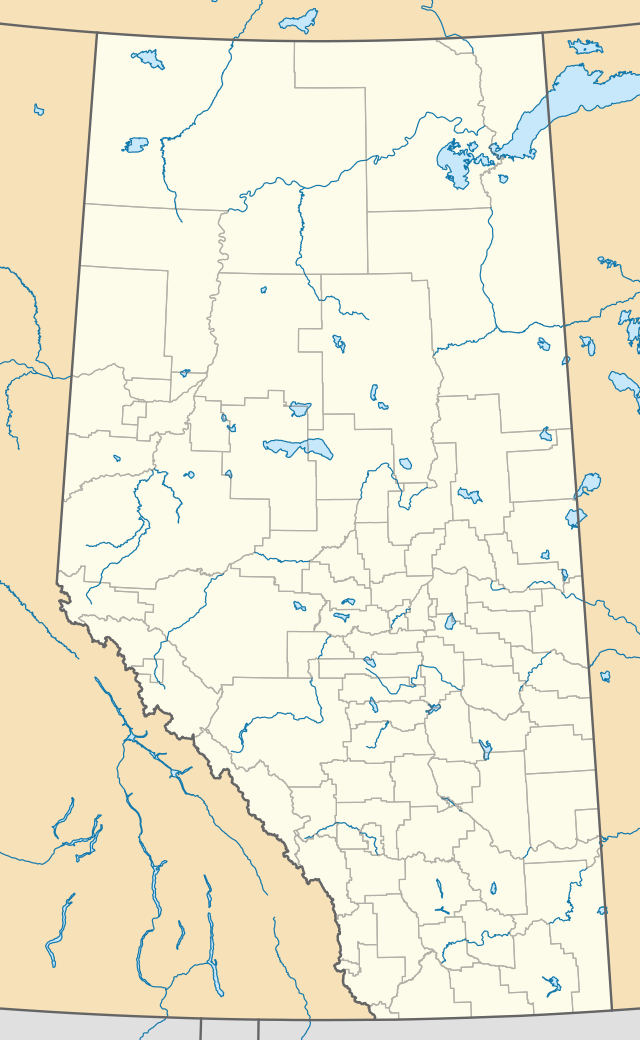Calling Lake, Alberta
Calling Lake is a hamlet in northern Alberta, Canada within the Municipal District of Opportunity No. 17.[3] It is located on Highway 813 along the eastern shore of Calling Lake, immediately north of Calling Lake Provincial Park. It is approximately 59 km (37 mi) north of Athabasca and 113 km (70 mi) south of Wabasca and has an elevation of 595 m (1,952 ft).
Calling Lake | |
|---|---|
 Location of Calling Lake in Alberta | |
| Coordinates: 55.2144°N 113.1969°W | |
| Country | |
| Province | |
| Census division | No. 17 |
| Municipal district | Municipal District of Opportunity No. 17 |
| Government | |
| • Type | Unincorporated |
| • Governing body | M.D. of Opportunity No. 17 Council |
| Area | |
| • Land | 15.55 km2 (6.00 sq mi) |
| Elevation | 595 m (1,952 ft) |
| Population (2016)[2] | |
| • Total | 448 |
| Population and land area was calculated by combining the figures for the designated places of Calling Lake and Centre Calling Lake. | |
| Time zone | UTC-7 (MST) |
The hamlet is located in the federal riding of Fort McMurray-Athabasca. The hamlet is the seat of the Jean Baptiste Gambler 183 Indian reserve of the Bigstone Cree Nation.
Calling Lake is recognized as two separate designated places by Statistics Canada – Calling Lake (which includes lands on either side of the Jean Baptiste Gambler 183 Indian reserve) and Centre Calling Lake (which is between the designated place of Calling Lake to the north and Calling Lake Provincial Park to the south).[4]
Infrastructure
Health services are provided by the Aspen Regional Health Authority, and the community is served by the Calling Lake Airport (TC LID: CFK4).
Demographics
As a designated place in the 2016 Census of Population conducted by Statistics Canada, by combining the designated places of "Calling Lake" and "Centre Calling Lake", Calling Lake recorded a population of 448 living in 159 of its 419 total private dwellings, a change of 58.2% from its 2011 population of 369. With a land area of 15.55 km2 (6.00 sq mi), it had a population density of 28.8/km2 (74.6/sq mi) in 2016.[1]
In the 2011 Census, by combining the designated places of "Calling Lake" and "Centre Calling Lake", Calling Lake had a population of 369 living in 134 of its 376 total dwellings, a 10.8% change from its 2006 population of 333. With a land area of 15.24 km2 (5.88 sq mi), it had a population density of 24.21/km2 (62.71/sq mi) in 2011.[2]
The population of Calling Lake according to the M.D. of Opportunity No. 17's 2007 municipal census is 415.[5]
Climate
| Climate data for Calling Lake | |||||||||||||
|---|---|---|---|---|---|---|---|---|---|---|---|---|---|
| Month | Jan | Feb | Mar | Apr | May | Jun | Jul | Aug | Sep | Oct | Nov | Dec | Year |
| Record high °C (°F) | 10.0 (50.0) |
14.0 (57.2) |
17.0 (62.6) |
29.0 (84.2) |
32.0 (89.6) |
33.0 (91.4) |
32.0 (89.6) |
32.5 (90.5) |
31.1 (88.0) |
27.0 (80.6) |
15.0 (59.0) |
9.0 (48.2) |
33.0 (91.4) |
| Average high °C (°F) | −9.4 (15.1) |
−5.2 (22.6) |
1.4 (34.5) |
9.4 (48.9) |
16.0 (60.8) |
20.0 (68.0) |
22.2 (72.0) |
21.3 (70.3) |
15.5 (59.9) |
8.4 (47.1) |
−2.4 (27.7) |
−8.1 (17.4) |
7.4 (45.3) |
| Daily mean °C (°F) | −15.7 (3.7) |
−12.4 (9.7) |
−5.7 (21.7) |
2.7 (36.9) |
9.0 (48.2) |
13.6 (56.5) |
16.1 (61.0) |
14.8 (58.6) |
9.4 (48.9) |
2.9 (37.2) |
−7.0 (19.4) |
−13.7 (7.3) |
1.2 (34.2) |
| Average low °C (°F) | −21.4 (−6.5) |
−19.5 (−3.1) |
−12.7 (9.1) |
−4.0 (24.8) |
1.9 (35.4) |
7.3 (45.1) |
9.9 (49.8) |
8.3 (46.9) |
3.1 (37.6) |
−2.6 (27.3) |
−11.5 (11.3) |
−19.1 (−2.4) |
−5.0 (23.0) |
| Record low °C (°F) | −46.7 (−52.1) |
−45.5 (−49.9) |
−42.0 (−43.6) |
−30.0 (−22.0) |
−11.5 (11.3) |
−4.4 (24.1) |
−2.0 (28.4) |
−5.5 (22.1) |
−9.4 (15.1) |
−21.5 (−6.7) |
−35.0 (−31.0) |
−48.0 (−54.4) |
−48.0 (−54.4) |
| Average precipitation mm (inches) | 21.7 (0.85) |
12.8 (0.50) |
14.1 (0.56) |
21.2 (0.83) |
46.9 (1.85) |
73.7 (2.90) |
93.6 (3.69) |
56.3 (2.22) |
35.5 (1.40) |
18.8 (0.74) |
17.3 (0.68) |
16.4 (0.65) |
428.3 (16.86) |
| Average rainfall mm (inches) | 0.5 (0.02) |
0.1 (0.00) |
1.5 (0.06) |
10.3 (0.41) |
43.1 (1.70) |
73.7 (2.90) |
93.6 (3.69) |
56.3 (2.22) |
35.4 (1.39) |
12.1 (0.48) |
1.6 (0.06) |
0.6 (0.02) |
328.5 (12.93) |
| Average snowfall cm (inches) | 23.3 (9.2) |
13.6 (5.4) |
13.7 (5.4) |
11.2 (4.4) |
3.9 (1.5) |
0 (0) |
0 (0) |
0 (0) |
0.1 (0.0) |
6.8 (2.7) |
16.5 (6.5) |
17.8 (7.0) |
107.0 (42.1) |
| Source: Environment Canada[6] | |||||||||||||
See also
References
- "Population and dwelling counts, for Canada, provinces and territories, and designated places, 2016 and 2011 censuses – 100% data (Alberta)". Statistics Canada. February 8, 2017. Retrieved February 13, 2017.
- "Population and dwelling counts, for Canada, provinces and territories, and designated places, 2011 and 2006 censuses (Alberta)". Statistics Canada. 2012-02-08. Retrieved 2012-04-06.
- Alberta Municipal Affairs (2010-04-01). "Specialized and Rural Municipalities and Their Communities" (PDF). Archived from the original (PDF) on 2012-02-29. Retrieved 2010-07-03.
- Statistics Canada (2007). "GeoSearch2006". Retrieved 2010-01-30.
- Prairie Wind Consulting Inc. (November 2009). "M.D. of Opportunity No. 17 Profile". Archived from the original on January 12, 2013. Retrieved February 10, 2010.
- Environment Canada—Canadian Climate Normals 1981–2010, accessed 07 March 2014